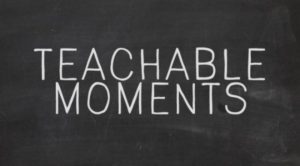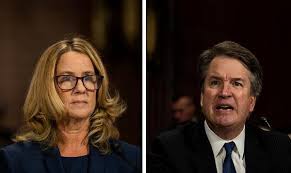 Teachable moments. A teachable moment is an unplanned, fleeting opportunity in which circumstance and readiness come together in a single experience. Such a moment provides a timely opportunity for a new insight to emerge. Effective teachers and parents recognize them. So do effective bosses and supervisors.
Teachable moments. A teachable moment is an unplanned, fleeting opportunity in which circumstance and readiness come together in a single experience. Such a moment provides a timely opportunity for a new insight to emerge. Effective teachers and parents recognize them. So do effective bosses and supervisors.
These moments of insight and growth rarely present themselves when things are going well. In those moments we are in no hurry to change anything. They more often come in the midst of confusion, conflict, loss, disappointment, or painfully discovering our limits. Whenever we feel vulnerable, confused, or lost, we are ripe for a teachable moment.
The classroom is not the only place for a teachable moment. They happen at home, at work, among friends, and on a national level.
We as a nation have seen many teachable moments come and go in the past months. Colin Kaepernick provided one such moment. Regardless of your position on his action, it is clear that people of good faith, true patriotism, and a strong desire for justice have come down on both sides.  The “Me, too” and “Time’s up” movements, as well as the current Supreme Court confirmation hearings, have given us many opportunities to broaden our understanding of and response to sexual assault. Every school shooting has provided fertile ground for genuine discussions about common sense responses to gun violence. Those are just a few of the many social and political issues that have the potential to be teachable moments for our nation.
The “Me, too” and “Time’s up” movements, as well as the current Supreme Court confirmation hearings, have given us many opportunities to broaden our understanding of and response to sexual assault. Every school shooting has provided fertile ground for genuine discussions about common sense responses to gun violence. Those are just a few of the many social and political issues that have the potential to be teachable moments for our nation.
One hallmark of effective leadership is the ability to identify and seize upon these teachable moments. To do so, the leader must recognize that the issues and the conflicts that follow are always more complex than they appear, that the “Why?” question never has an easy answer. Teachable moments show up when we recognize that we don’t understand the complexity and we don’t have a simple “why.” At that point we are ready for something new.
Sadly, our president has consistently chosen to ignore teachable moments. He seems unaware of nuance and complexity. His approach is to simplify the issue, to make disparaging statements about those who disagree with him, and to encourage his followers to take his side. He has chosen division by making every issue a forced choice, an “us against them” situation.
Effective leaders understand that when people have conflicts, it is because they value different things or they fear different things, not simply because one side is right and the other is wrong. Again, our president seems unaware of this reality.
In every conflict the leader has at least two options.
One option is to bring conflicted parties together, not to get them to agree, but talk, listen, and provide the possibility of seeing the conflict more broadly. This may produce a resolution that suits both sides, but at the least it creates greater understanding. It will also likely reveal that the two opposing sides have some areas of agreement they didn’t recognize. That’s a teachable moment. The other option is to divide by simplifying and moralizing the issue, thus allowing those in conflict to get more entrenched in their own views and more opposed to the other views.
The latter is the approach most often used by our president, though it is not exclusive to the president. As a nation we’ve never been very good at managing disagreements, but the impulse to divide rather than communicate has trickled down into all levels of government and into our social structures so that it is starting to feel normal and inevitable.
A friend of mine is a model for being open to teachable moments. He occasionally calls people who write letters to the editor that he strongly disagrees with. He invites them to have coffee with him. He has no intention of changing their minds. He simply wants to find out how they came to the beliefs and conclusions they came to. I asked why he does such a bizarre thing. He simply responded, “It’s always amazing what I find out.”
Circumstance and readiness coming together over coffee.
2 Comments until now
So well said. What a dream to have a true leader. Maybe someday again.
John,
I really enjoyed catching up with you and Judy on Thursday. I read the Teachable Moment piece, and I ‘d like your permission to use part of it in a devotional I’m doing tomorrow afternoon at church. I’m an elder at Sourh Hills Christian (Disciples of Christ) and have been asked to offer a prayer/devotional sentences for the church board meeting.
Add your Comment!